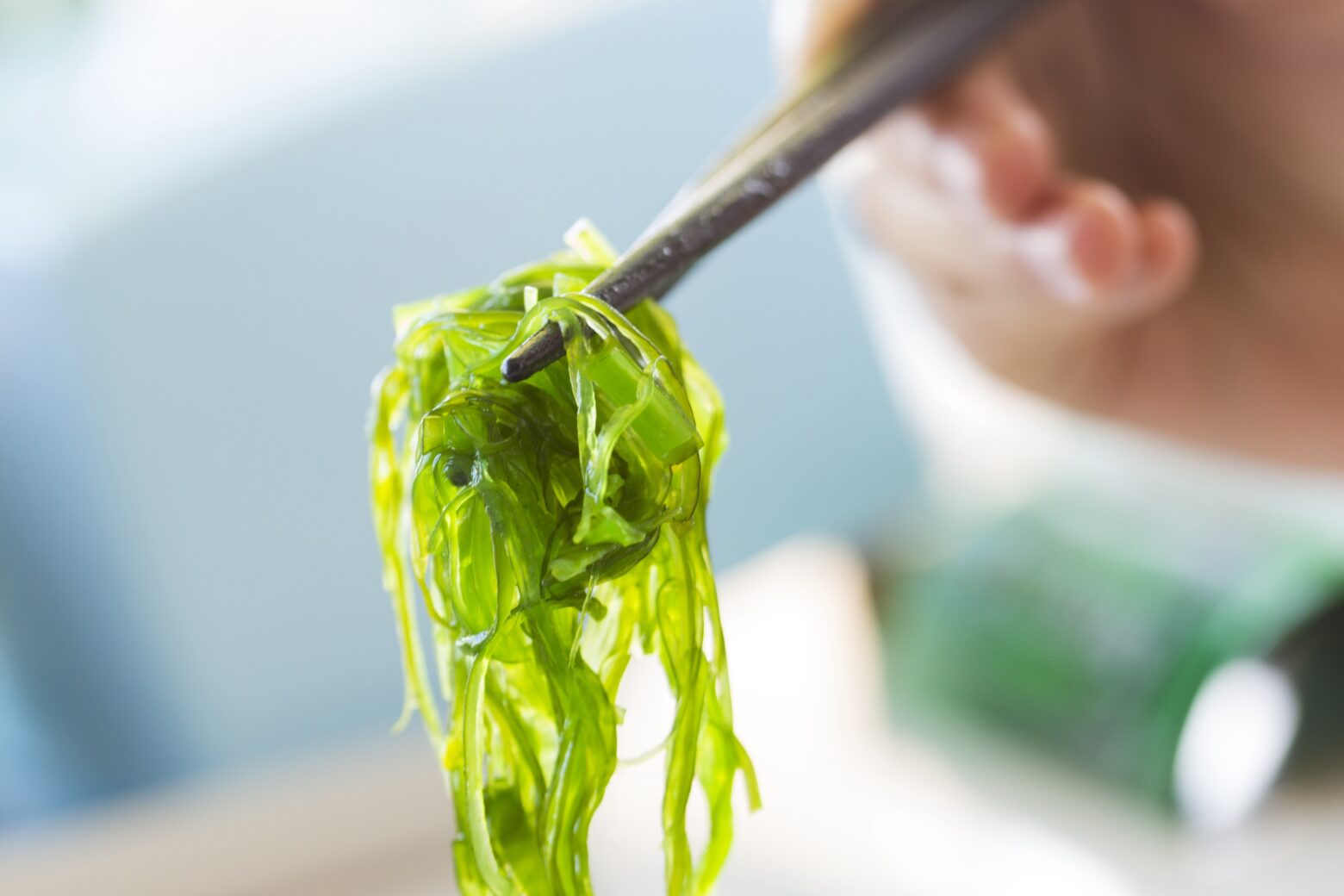Are Algae and Seaweed “Superfoods”?

As competition for land resources and space increases, should we turn to the 70 percent of the planet that is underwater for additional food production? Can aquatic plants be our “nutritional saviors”? If we are compelled by future necessity to do so, must we undo our Paleo lifestyle and eating habits?
These are valid questions considering the world’s population. The challenge is becoming increasingly difficult to feed the growing multitude in ways that are sustainable and make sense nutritionally.
Popular media often refer to algae and seaweeds as “superfoods.” Is this designation justified? Realistically, do they deserve a seat at dinner tables around the world?
While the consumption of aquatic plants may seem novel to many of us, the seas, lakes, and rivers of the world have been a source of plant nourishment for many cultures for millennia.[1]
Freshwater microalgae (i.e., small, and microscopic varieties) in the genera Spirulina, Chlorella, Odontella, Tetraselmis, Aphanizomenon, Nostoc, Spirogyra, and Oedogonium have been routinely consumed on multiple continents, including in Mexico, Chad, Thailand, India, and China.
Marine macroalgae (i.e., those most often found in saltwater environments and commonly referred to as seaweeds) are highly valued as well. Asian cultures (Japan, China, Southeast Asia) have used macroalgae as food and medicinally throughout much of recorded history.[2]
From a cultural point of view, most Americans are not accustomed to turning to aquatic environments as a source of plant food. We rely almost entirely on terrestrial farms as sources of plants and row crops.
Is there scientific justification for consumption of aquatic plants? Let us take a closer look at algae and seaweeds from a nutritional perspective.
The Nutritional Value of Aquatic Plants
As the table below shows [3], microalgae and macroalgae are quite nutritious, especially if you normalize the values (i.e., “compensate” or make an equivalent comparison based on dried samples of each).
Using that type of comparison, algae are relatively high in fiber, low in saturated fats, and high in protein and essential amino acids, which we must consume to survive—our bodies cannot synthesize them (hence, the term “essential”). Interestingly, terrestrial plants tend to have amino acid profiles that are less favorable [3]; thus, for that fact alone, aquatic plants are valuable to human nutrition.
| Item | Fiber (g) | Protein (g) |
Vitamins | Minerals |
| Dulse (dried) | 28.6 | 28.6 | A, C | Ca, Fe |
| “Seaweed” (wet) | 0.7 | 3.5 | A,B12, C, E, K, Folate | Ca, Fe, Mg, P, K, Zn, Cu, Se |
| Kelp (wet) | 1.3 | 1.7 | A, B1, B2, B3, B6, B12, C, E, K, Folate | Ca, Fe, Mg, P, K, Zn, Cu, Mn, Se |
| Nore (dried) | 45.5 | 45.5 | A, C | Ca, Fe |
| Sea purslane (wet) | 0.0 | 2.0 | A, B1, B2, B3, B6, C, Folate | Ca, Fe, Mg, P, K, Zn, Cu, Mn, Se |
| Seaweed salad (Japanese; wet) | 4.4 | 0.0 | A | Ca, Fe |
| Spirulina (wet) | 0.4 | 5.9 | A, B1, B2, B3, B6, B12, C, E, K, Folate | Ca, Fe, Mg, P, K, Zn, Cu, Mn, Se |
| Spirulina (dried) | 3.6 | 57.5 | A, B1, B2, B3, B6, B12, C, E, K, Folate | Ca, Fe, Mg, P, K, Zn, Cu, Mn, Se |
| Chlorella (dried) | 0.0 | 60.0 | A, B12, C | Ca, Fe |
Table 1. Seaweed/algae nutritional values per 100 gram serving (USDA FoodData Central database). Ca = Calcium, Fe = Iron, Mg = Magnesium, Mn = Manganese, P = Phosphorus, K = Potassium, Cu = Copper, Se = Selenium, Zn = Zinc
Even more impressive, algae and seaweeds contain copious amounts of vitamins and minerals. Far from being merely “survival food,” a term used to define many terrestrial grains [5,6], these plants can be placed on the other end of the spectrum—health food.
One of the few drawbacks to marine macroalgae and seaweeds is their tendency to retain sodium from the seawater in which they grow. However, careful preparation before cooking and consumption, through rinsing and soaking, removes traces of seawater and will minimize sodium intake.
Additionally, these plants contain relatively high concentrations of potassium—an element, when paired and consumed in higher proportions than sodium, that helps mitigate many of sodium’s negative health effects.[7,8]
The evidence above appears to suggest algae and seaweed can be included in The Paleo Diet. We might even say they could be used as alternatives to more traditional plant foodstuffs. All things considered, the inclusion of algae and seaweeds as part of an otherwise well-rounded Paleo regimen appears to be appropriate.
The Practicality and Sustainability of Aquatic Plants
Based on their nutritional profiles, aquatic microalgae and macroalgae appear to be the “superfoods” we hope and expect. But does it make sense to produce them? Can it be done economically and affordably? As we search for sustainable solutions to food production, do algae fit into a future food paradigm? There is strong evidence that the answer is yes to each of these questions.
Ongoing research at institutions such as Harbor Branch Oceanographic Institute of Florida Atlantic University suggests that algae and seaweed production can solve multiple problems at the same time.[9]
A team headed by Dr. Paul Wills and Dr. Megan Davis have successfully raised Sea Asparagus (Salicornia bigelovii), Sea Purslane (Sesuvium portalacastrum), and Saltwort (Batis maritima) as food items in pilot-scale systems. In addition, and to demonstrate sustainability and the closing of nutrient cycles, these plants were successfully raised at their facility using fertile wastewater from saltwater fish aquaculture systems—a technique known as integrated multi-trophic aquaculture (IMTA), which avoids concerns about pollution in bodies of water that might otherwise receive more highly concentrated and overly fertile discharge.
Closing nutrient cycles and avoiding pollution extends to the atmosphere as well. Photosynthetic plants, of course—and including algae and seaweeds—require carbon dioxide to live and grow and expel oxygen as a byproduct. The oceans are a primary sink for atmospheric carbon dioxide. At commercial scales of production and consumption, algae production for food could be an easy way to (1) recycle and sequester carbon dioxide, (2) slow or bring down concentrations of an important greenhouse gas, and (3) feed us at the same time.[10]
On larger scales, today we see interest and investment in algae production by large corporations such as DuPont, Cargill, Beijing Leili Marine Bioindustry, and Mara Seaweed, to name just a few. [11]
The market for spirulina products alone is expected to reach $630 million by the year 2025. [12] The interest and investment alone by these credible organizations is strong evidence that production makes economic sense on commercial scales.
Overall, the production of aquatic plants is impressive and growing rapidly. Total annual worldwide production has nearly doubled in the past 10 years to more than 32 million metric tons, with a value that exceeds $13.3 billion, with the overwhelming majority—not surprisingly—produced in Asia. [13]
As we ponder our futures, we must seriously consider the paths we take to support ourselves. Algae and seaweeds not only appear to be beneficial to humanity in a nutritional and Paleo sense, but also bring us closer to living within our means and environmental limitations on the Earth.
References
[1] Garcia, J.L. et al. 2017. Microalgae, old sustainable food and fashion nutraceuticals. Microbiological Biotechnology 2017 Sep; 10(5): 1017–1024. doi: 10.1111/1751-7915.12800
[2] Anonymous. 2020. History of phycology. Wikipedia. https://en.wikipedia.org/wiki/…;
[3] USDA. 2020. Nutrient Database: FoodData Central. https://fdc.nal.usda.gov/ ;
[4] Anonymous. 2016. Getting essential amino acids on a plant-based diet. https://www.deliverlean.com/ge…;
[5] Anonymous. 2021. Which grain deserves a spot in your survival stockpile? https://www.tactical.com/grain…;
[6] Hoover, C. 2020. Survival skills: long term food storage of grains. https://skyaboveus.com/wildern…;
[7] Anonymous. 2018. The role of potassium and sodium in your diet. Salt. Centers for Disease Control and Prevention. https://www.cdc.gov/salt/potas…;
[8] Bhatt, D.L. 2019. Can a salt substitute cause high potassium levels? Harvard Heart Letter. https://www.health.harvard.edu…;
[9] Galoustian, G. 2020. Could these ‘salt-loving’ edible sea vegetables be the new kale? Florida Atlantic University. https://www.fau.edu/newsdesk/a…;
[10] Lamm, B. 2019. Algae might be a secret weapon to combatting climate change. Quartz. https://qz.com/1718988/algae-m…;
[11] IMARC Group. 2020. Top companies in global seaweed market. IMARC Group. https://www.imarcgroup.com/top…;
[12] Meticulous Market Research. 2019. Meticulous Market Research Pvt. Ltd. https://www.globenewswire.com/…;
[13] Food and Agriculture Organization of the United Nations. 2020. Fishery and aquaculture statistics 2018. UNFAO. http://www.fao.org/3/cb1213t/C…;
Bill Manci
Bill Manci is the president of a fisheries and aquaculture consulting company and he has worked with The Paleo Diet since 2002.
More About The Author




